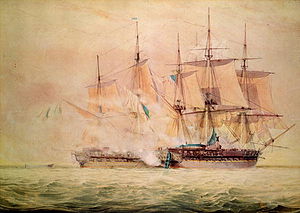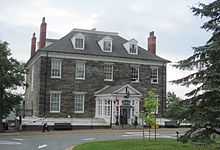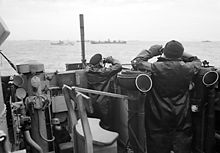- North America and West Indies Station
-
North American and West Indies Station 
The capture of USS Chesapeake on 1 June 1813 as depicted by John Christian SchetkyActive North American Station (1745–1818)
North America and West Indies Station (1818–1926)
America and West Indies Station (1926–1956)
West Indies (1956–1976)
HMS Malabar (1976–1995)Country United Kingdom, Bermuda, and Canada Branch  Royal Navy
Royal NavyType Naval squadron & fleet Part of Royal Navy Garrison/HQ Royal Naval Dockyard, Halifax &
Royal Naval Dockyard, BermudaNotable ships HMS Fame, HMS Invincible, HMS Leopard, HMS Resolute Engagements Battle of the Chesapeake, Battle of Cape Henry, Siege of Yorktown, Battle of St. Kitts (1781–1782)
USS Constitution vs HMS Guerriere, Capture of HMS Frolic, Capture of USS Chesapeake, Capture of HMS Boxer, Battle of Baltimore (1812–1814),
pursuit of SM U-53 (1916),
Battle of the Atlantic (1939–1945)Disbanded 1 April 1976 - For American naval forces in the West Indies, see West Indies Squadron (United States).
The North American and West Indies Station was a formation or command of the United Kingdom's Royal Navy stationed in North American waters from 1745 until the 1950s. During some periods the North American Station (NA) was separated from with the West Indies station (WI) and known as the North American Station.
Contents
History
The squadron was formed in 1745 to counter French forces in North America. It was based initially at Halifax Naval Yard in Nova Scotia. In 1818, its main base was moved to Bermuda which was better positioned to counter threats from the United States.[1] The Royal Navy had created a permanent establishment in Bermuda in 1795, and began buying land around the archipelago for the development of a naval base including what became the Royal Naval Dockyard, Bermuda. Up until 1899 there were separate North American and West Indies stations.
 Admiralty House, Halifax, summer headquarters of the Admiral in command of the station
Admiralty House, Halifax, summer headquarters of the Admiral in command of the station
The squadron was maintained at varying strength throughout the late 19th and early 20th centuries. In addition to the base at Bermuda, where there was a dockyard until 1951, the squadron continued to make use of the great fortified harbours that were available at Royal Naval Dockyard, Halifax - Halifax, Nova Scotia, Canada - now CFB Halifax. During World War II, Canada developed Sydney, Nova Scotia as an alternate convoy port.
British ports in the Caribbean, such as Kingston, Jamaica and Port of Spain, Trinidad were available for rest, refueling, and supplies as was St. John's, Newfoundland in the far northeast, the closest port in North America to any British port in the United Kingdom.
The main role of the station was to keep the trade routes open to North America and the Caribbean. Generally, several cruisers and smaller ships were kept on this station. During war time the squadron operated in cooperation with the Royal Canadian Navy.
In 1910, the Royal Navy in North American waters was replaced by the Royal Canadian Navy, and the station headquarters shifted south to Bermuda. In 1926 the appointment was redesignated Commander-in-Chief, America and West Indies, which was the title until the 1950s. After the closure of Royal Naval Dockyard, Bermuda in 1958, HMS Malabar served as the succeeding station until 1995.
The Commander-in-Chief, Vice Admiral Sir William Andrewes, was the initial Deputy Supreme Allied Commander Atlantic after World War II (circa 1952 and afterwards).[2] On 29 October 1956, the command became Senior Naval Officer West Indies (SNOWI), which was finally disbanded on 1 April 1976. SNOWI served as Island Commander Bermuda in the NATO chain of command, reporting to Commander-in-Chief, Western Atlantic as part of SACLANT.[3]
From around 1931-33 to at least 1939, the South American Division of the station was active, under Commodore R.H.O. Lane-Poole, O.B.E., R.N., on formation, and then Commodore Henry Harwood at the Battle of the River Plate.
For ships stationed in Canada and North America go to List of Royal Navy ships in North America.
Commanders-in-Chief
 Royal Navy facilities in Canada
Royal Navy facilities in CanadaStations North American Station • Pacific Station • Provincial Marine
Dockyards and depots Amherstburg • Esquimalt • Grand River • Halifax • Ile aux Noix • Kingston • Penetanguishene • Navy Island • York
Ships  On lookout for U-boats in the Second Battle of the Atlantic, October 1941
On lookout for U-boats in the Second Battle of the Atlantic, October 1941
Commanders of the Station have included:[4][5][6][7][8]
North American Station- Commodore Augustus Keppel (1751-1755)
- Commodore Lord Alexander Colville (November 1759 - October 1762)
- Commodore Richard Spry (October 1762 - October 1763)
- Rear Admiral Lord Alexander Colville (October 1763 - September 1766)
- Captain Joseph Deane, September 1766 - November 1766 (Senior Captain)
- Captain Archibald Kennedy, November 1766 - July 1767 (Senior Captain)
- Commodore Samuel Hood (July 1767 - October 1770)
- Commodore James Gambier (October 1770 - August 1771)
- Rear Admiral John Montagu (August 1771 - June 1774)
- Vice Admiral Samuel Graves (June 1774 - January 1776)
- Vice Admiral Richard Howe (February 1776 - September 1778)
- Vice Admiral James Gambier (1778 - 1779)
- Vice Admiral John Byron (1779)
- Vice Admiral Mariot Arbuthnot (1779-1781)
- Vice Admiral Sir Thomas Graves (1781)
- Rear Admiral Robert Digby (1781 - 1783)
- Rear Admiral Sir Charles Douglas (1783 - 1785)
- Vice Admiral Sir Herbert Sawyer (1785 - 1789)
- Vice Admiral Sir Richard Hughes (1789 - 1792)
- Vice Admiral George Murray (1793 - 1796)
- Vice Admiral George Vandeput (1797 - 1800)
- Vice Admiral Sir William Parker (1800-1802)
- Vice Admiral Sir Andrew Mitchell (1802 - 1806)
- Vice Admiral Sir George Cranfield-Berkeley (1806 - 1807)
- Vice Admiral Sir John Warren (1807 - 1810)
- Vice Admiral Sir Herbert Sawyer (1810 - 1813)
- Vice Admiral Sir John Warren (1813 - 1814)
- Vice Admiral Sir Alexander Cochrane (1814 - 1815)
- Vice Admiral Sir David Milne (1816)
- Vice Admiral Sir Edward Colpoys (1816 - 1821)
North America and West Indies Station
- Vice Admiral Sir William Fahie (1821 - 1824)
- Vice Admiral Sir Thomas Lake (1824 - 1827)
- Vice Admiral Sir Charles Ogle (1827 - 1830)
- Vice Admiral Sir Edward Colpoys (1830 - 1832)
- Vice Admiral Sir George Cockburn (1832 - 1836)
- Vice Admiral Sir Peter Halkett (1836 - 1837)
- Vice Admiral Sir Charles Paget (1837 - 1839)
- Vice Admiral Sir Thomas Harvey (1839 - 1841)
- Vice Admiral Sir Charles Adam (1841 - 1844)
- Vice Admiral Sir Francis Austen (1844 - 1848)
- Vice Admiral Sir Thomas Cochrane (1848 - 1851)
- Vice Admiral Sir George Seymour (1851 - 1853)
- Vice Admiral Sir Arthur Fanshawe (1853 - 1856)
- Vice Admiral Sir Houston Stewart (1856 - 1860)
- Vice Admiral Sir Alexander Milne (1860 - 1864)
- Vice Admiral Sir James Hope (1864 - 1867)
- Vice Admiral Sir Rodney Mundy (1867 - 1869)
- Vice Admiral Sir George Wellesley (1869 - 1870)
- Vice Admiral Sir Edward Fanshawe (1870 - 1873)
- Vice Admiral Sir George Wellesley (1873 - 1875)
- Vice Admiral Sir Astley Key (1875 - 1878)
- Vice Admiral Sir Edward Inglefield (1878 - 1879)
- Vice Admiral Sir Francis McClintock (1879 - 1882)
- Vice Admiral Sir John Commerell (1882 - 1885)
- Vice Admiral The Earl of Clanwilliam (1885 - 1886)
- Vice Admiral Sir Algernon Lyons (1886 - 1888)
- Vice Admiral Sir George Watson (1888 - 1891)
- Vice Admiral Sir John Hopkins (1891 - 1895)
- Vice Admiral Sir James Erskine (1895 - 1897)
- Vice Admiral Sir Jackie Fisher (1897 - 1899)
- Vice Admiral Sir Frederick Bedford (1899 - 1903)
- Vice Admiral Sir Archibald Douglas (1903 - 1904)
- Vice Admiral Sir Day Bosanquet (1904 - 1907)
- Vacant (1907 - 1914)
- Vice Admiral Sir George Patey (1915 - 1916)
- Vice Admiral Sir Montague Browning (1916 - 1918)
- Vice Admiral Sir William Grant (1918 - 1919)
- Vice Admiral Sir Morgan Singer (1919)
- Vice Admiral Sir Trevylyan Napier (1919 - 1920)
- Vice Admiral Sir William Pakenham (1920 - 1923)
- Vice Admiral Sir Michael Culme-Seymour (1923 - 1924)
- Vice Admiral Sir James Fergusson (1924 - 1926)
America and West Indies Station
- Vice Admiral Sir Walter Cowan (1926 - 1928)
- Vice Admiral Sir Cyril Fuller (1928 - 1930)
- Vice Admiral Sir Vernon Haggard (1930 - 1932)
- Vice Admiral Sir Reginald Plunkett (1932 - 1934)
- Vice Admiral Sir Matthew Best (1934 - 1937)
- Vice Admiral Sir Sidney Meyrick (1937 - 1940)
- Vice Admiral Sir Charles Kennedy-Purvis (1940 - 1942)
- Vice Admiral Sir Alban Curteis (1942 - 1944)
- Vice Admiral Sir Irvine Glennie (1944 -1945)
- Vice Admiral Sir William Tennant (1946 - 1949)
- Vice Admiral Sir Richard Symonds-Tayler (1949 - 1951)
- Vice Admiral Sir William Andrewes (1951 - 1953)
- Vice Admiral Sir John Stevens (1953 - 1955)
- Vice Admiral Sir John Eaton (1955 - 1956)
See also
References
- ^ Gwyn, Julian, Frigates and Foremasts: The North American Squadron in Nova Scotia Waters, 1745-1815 Vancouver, BC: UBC Press (2004) ISBN 9780774809115. OCLC 144078613
- ^ Sean M. Maloney, 'To Secure Command of the Sea: NATO Command Organization and Naval Planning for the Cold War at Sea, 1945-54,' MA thesis, University of New Brunswick, 1991, p.198 and Chapter 4 generally
- ^ UK Chiefs of Staff Committee, Command in the Caribbean, DEFE 5/188/4, January 1971, via The National Archives
- ^ Stout, Neil R. The Royal Navy in America, 1760-1775: A Study of Enforcement of British Colonial Policy in the Era of the American Revolution. Naval Institute Press, Annapolis, MD, 1973, p.199 via Gaspee Virtual Archives: Research Notes on Admiral John Montagu
- ^ Commanders-in-Chief, North America, 1830-99
- ^ Commanders-in-Chief 1904 - 1975
- ^ Bermuda's Royal Navy base at Ireland Island from 1815 to the 1960s
- ^ Senior Royal Navy appointments
External links
- Leo Niehorster, Station as at 3 September 1939
Categories:- Royal Navy stations
- Military of Bermuda
- History of Nova Scotia
- Military history of the Atlantic Ocean
Wikimedia Foundation. 2010.
